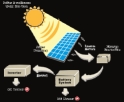
Getting Familiar with Equipment
Before going any further you’ll want to familiarize yourself with the different solar products and what they do. Depending on how you are going to setup your solar power system, individual components may be combined into another pieces of hardware or may not be used at all. It is however essential to know what all these things are and whether you’ll need them.
DC Power – (Direct Current) This is the type of current produced by solar panels and wind turbines. It is also the type of current stored and discharged from batteries. DC cannot power traditional home appliances by itself. Solar power systems are usually 12 or 24 volts. The blowhard Thomas Edison is mostly credited for DC power and erroneously, electricity in general.
AC Power – (Alternating Current) This is current powering your home today and is commonly referred to as 110v. If you are going to feed power back to the utility company, this is what they will want. The genius Nikola Tesla is the true inventor of modern electricity, Edison be damned.
Solar Power Panels – (also known as PV Panels or Photovoltaics) These are essential to any solar project. They are what converts the suns rays into electric power. They can be made out of different materials and have differing amounts of efficiency in converting sunlight into electricity. They also will vary widely in size and cost. Here is a site that gives a brief run down of the major types of solar panels.
Power Inverter – This is a device that converts DC power created by your solar panels and changes it to AC current to supply energy for your home or the power grid. A power invert usually has standard AC outlets that you can plug things into & it can be connected to your homes circuit breaker for power distribution through the house. It can be a stand alone device in your system or some modern panels come with micro-inverters integrated into them. The integrated kind could only be used in a grid-tied setup that doesn’t need to charge batteries. (panels would ultimately be producing AC power & batteries need DC)
Grid Tie Inverter w/ Battery Backup – A special type of inverter that is needed in a hybrid solar power setup where you are able to feed excess energy to the power grid and have emergency battery backup power when the grid is down. You should check with the utility company to see if they will allow this type of connection to their infrastructure. It may also need to be installed by a certified electrician and meet certain specifications.
Charge Controller – (also known as Solar Regulators) This is what moderates the energy to and from your batteries to ensure that they are not under or over charged. The input to the charge controller comes from the solar panels. The output is usually connected to the storage batteries and inverter. The charge controller may also be included inside another component of the system depending on your setup. The stand alone controllers are relatively inexpensive but play an important role.
Solar Power Storage Batteries – These are needed if your system is to provide backup / emergency power or if you’re living off grid. For residential solar power storage, deep cycle (or deep cell) lead acid batteries are typically used due to their properties. You can use marine, golf cart, car batteries, etc. There are many technical things to consider when buying this expensive component. I’ll provide some links for more battery information at the end of this guide.
Inline Fuses – These cheap little guys sacrifice themselves in the event of short circuit or over voltage. They protect the devices connected to them from electrical damage by breaking the circuit. They are usually found between panels and charge controllers. The inverter will also be fused.
Battery Tender / Trickle Charger – These are plugged into an AC power outlet and fed to your batteries. They ensure that the batteries remain fully charged regardless of the amount of energy your panels are producing. The chargers can also provide diagnostic data and the charge within the batteries. They help extend the life of your batteries and are pretty inexpensive.
Desulfater / Desulfation Device – Product that is connected to the batteries to drastically extend their life by doing some wiz-bang stuff with the batteries internal chemistry. Some chargers have these integrated or can be separate units.
Wiring – Insulated conductors used to transport electricity. (hehe) The size / type of wiring between solar power components should be considered carefully. Choosing the wrong gauge can waste energy & even be very dangerous.
OK, those are most of the components used in setting up a DIY solar power system. Next I’ll explore where these things fit into your particular system.









